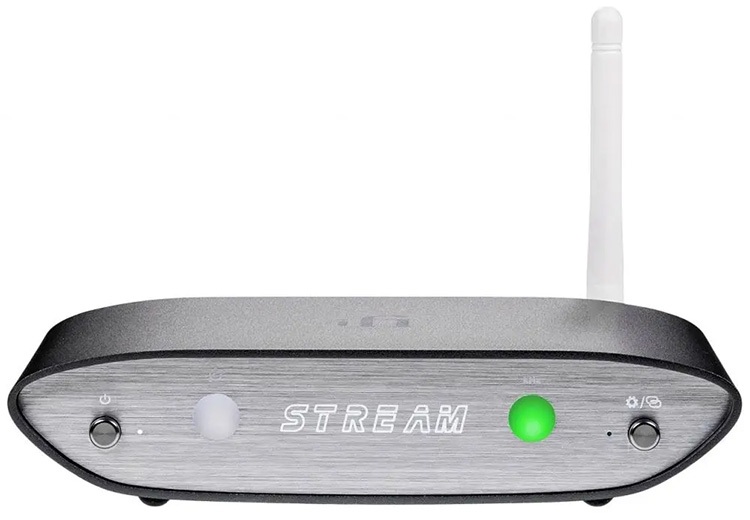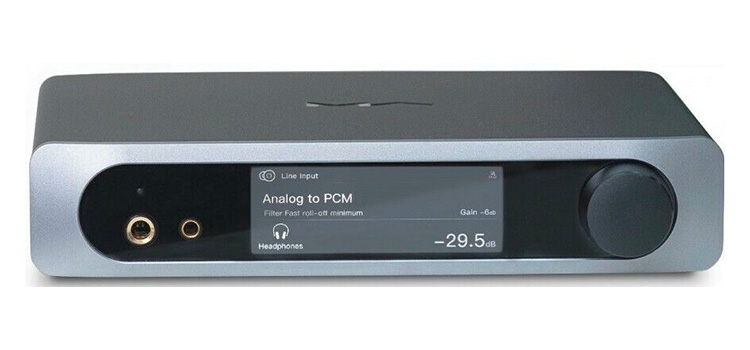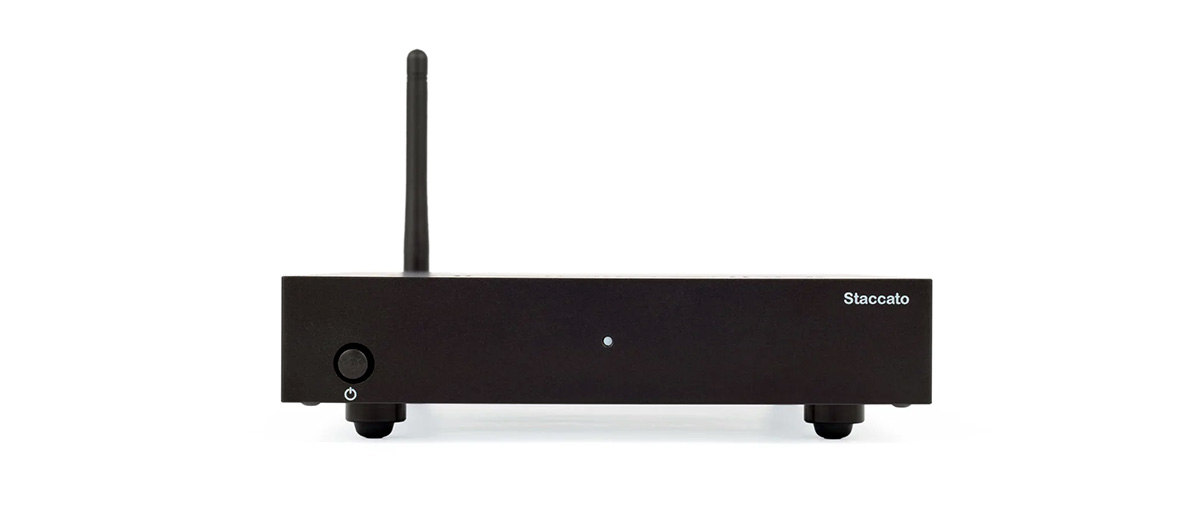Sound Impressions
Not only do I find the Staccato much more resolving and truer sounding than listening wired, but I also appreciate as well its charismatic reproduction of music that is permeated with finesse and experience.
It justly does so since in sitting pretty much at the top of the chain, the job of the Staccato doesn’t end with managing digital signals.
Listening to the play of tightness between a short synth beat and a continuous snare drum, the vivid layering is very distinct. Here, the dynamics have the range to emphasize deeply the energy variance of the two.
Deeper and heavier kicks diffuse cleanly and evenly supporting the initial speed of the main thump.
In addition, I also found that the rumble of a bass string has a slight pep to it that is easy to miss but will surely grab the attention coming after the satisfying bite of each pluck.
The profound contrast coming from the black background allows understated information like the lips shutting together and clap accompaniment to be nothing short of amazing.
It comes in handy together with the convincing stage placement of the Staccato wherein a choir gets the subtleties to not sound compressed.
Female singers keeping a normal tone will play at pace with the rest of the song. Nothing will sound forced and the size of the voice is well-behaved and staged further away.
Going back to the timbre of snare drums, it has a diffused and pliant quality which in my opinion is not as flat and hard sounding when I heard the same song wired.
Building on this, the sensation of having the ability to discern the skill of the player is there as well as the precision to not blur the time the stick hits the instrument from its reverb.
Synergy
Pairings
I later paired the Staccato with the Chord Qutest and CH-Amp but first I fired up the Burson Conductor 3 Reference for more neutral listening impressions.
Together with the Audio-Technica ATH-ADX5000, the dynamic qualities of the Staccato shined easily as it resolved quite well in the process revealing its advantages as a standalone streaming box.
With the Sennheiser HD600, the power and fullness of the midrange are retained while the size of the image and airiness are boosted making it more engaging.
The Staccato adds some emphasis on the deeper end but on the other hand, it wasn’t able to shine as much with the blunted jingling of the tambourine.
Since the Staccato is also not bright-leaning by default, the Dan Clark Audio Ether 2 will be a guilty pleasure for those wanting a quality treble extension without being bombarded with vitality.
The Ether 2 softens the bass more than both the HD600 and the ATH-ADX5000 concluding with a slower and thicker reverb.
Having the Qutest and CH-Amp hooked together, the pairing came to be a technically rich sound that is more expressively engaging.
Since the low-end sticks longer and the vocal timbre is on the fluid side, this pairing suits dynamic headphones like the ATH-ADX5000 well since it has a lean sound signature on its own. The blend improves the fullness of sound and yet it knows to stay clean and precise.

Select Comparisons
iFi Audio ZEN Stream
$399
Technical
The marketing team of iFi Audio and EarMen couldn’t be more different from one another seeing the spec list of the Zen Stream fully discussed in detail.
iFi Audio isn’t wasting any effort though since even with its more affordable price tag, it does have some hardware integrations that raise its price-to-performance ratio.
Aside from Spotify and Tidal Connect, the Zen Stream is also Roon ready as well as Airplay compatible. And unlike the Staccato, chord cutters can simply set the Zen Stream up to connect via WIFI while still having the option of using the ethernet if needed.
Operating the Zen Stream can be done via an accompanying app that is also available for download to mobile devices.
Surprisingly, there is no optical output in the Zen Stream. Only a single coax output with an iPurifier and a more modern USB 3.0 with active noise cancellation is available.
The sum of its parts plus the exclusive modes that let users set the Zen Stream into a particular use case scenario to minimize software jitter is what makes it a pretty compelling offer.
Design
When the original Zen Can launched, I was one of the first who took the plunge partially because it is such a slim and elegant device. Fast forward to today, the company seeing its success has kept the timeless design across the Zen range.
The Zen Stream, in my opinion, has a modern architecture twist, reminding me of an airport or museum. I wouldn’t put it over the Staccato yet since once turned on, I am more partial to the simpler face of the Staccato than the louder LED feedback method folks over at iFi decided on using.
As I placed the Zen Stream beside the Staccato, the overall height of the former is lower due to its shorter legs even though its main chassis is thicker by a couple of millimeters.
Its footprint on the other hand is slightly wider than the Staccato but it lacks depth since the EarMen streamer is squarish by default.
Performance
The cohesiveness of sustained bass notes is par for the course on the iFi camp, but still, the tightness and ease of isolation between neighboring instruments is a lot easier on the Staccato.
It was also quite obvious that the Zen Stream emphasizes the mid-bass more and touches the presentation to be softer.
Showing a difference in bite, the Zen Stream grabs hard in each pluck of the string indicating a snappier edge than the Staccato. The Staccato is maintaining a more even-handed approach letting the reverb dynamically appear without sounding artificial.
Again, with the Zen Stream being more forward in the vocal section, singers are occupying a spatially bigger area. And with a thicker lower midrange as well, the Zen Stream is tuned to assist with the weight of male singers wherein the Staccato stays drier and airier.
The Zen Stream is capable of sifting through a challenging electric guitar passage. Where the Staccato shows its ace is in its capacity to dive deeper into the sound in a manner that is coherent and smooth.

Matrix Audio mini-i Pro 3
$1,025
Technical
There’s a lot to talk about the mini-i Pro 3 if spec alone is the basis. But as a similarly priced product, its strike zone is still not quite the same owing to the bigger device being positioned as an all-in-one streamer/DAC/amp.
To begin with the heart of the matter, the mini-i Pro 3 is a less sophisticated streamer with no streaming services integration nor a dedicated app controller.
While it has both Wi-Fi and LAN connectivity, it is only limited to pair via Airplay and as a Roon endpoint, the same two functions I wish the Staccato is capable off.
Going deeper into the hardware side of things, there is a single ES9038Q2M allowing MQA decoding. The WIFI antenna also doubles as a Bluetooth receiver which extends the use case of the mini-i Pro 3 for streaming.
With a fully balanced amplifier circuitry, the front and rear of the mini-i Pro 3 are busier with analog connectivity options.
Speaking of which, since the mini-i Pro 3 is a feature-rich device minus a companion app, controlling it can be done through the multifunctional knob in front or the physical remote provided.
Design
Combining three devices in one, there is no reason to be surprised that the mini-i Pro 3 is the chunkier of the two. And maybe due to a large number of components inside, it also needed air vents located on its sides and bottom.
Not that far from the understated look of the Staccato, the mini-i Pro 3 also follows a straightforward yet slightly more interesting application helped by the two-tone outline and the full-color display.
The front is also flanked by a dim glass panel with headphone sockets and volume control on opposite ends. So, while the mini-i Pro 3 is also easily hidden away, its façade is a lot nicer to appreciate.
Having a beefier case, Matrix Audio has a lot more room to cover in terms of rear IO. And since it has an internal power supply along with its long list of connectivity options displayed in the rear, the mini-i Pro 3 has space left for an IEC socket.
Performance
As a streaming device, the mini-i Pro 3 is not as transparent as the Staccato. I’m finding it to be more playful with its qualities making it stand out more than simply disappearing in the background.
Immediately, the softness and slowness of the mini-i Pro 3 in the bass region hit me with unexpected differentiation. It is more laid back mixed with girth making it slightly harder to dissect the delineation of a bass guitar.
Instrument placement is much more precise on the Staccato because of the tighter and cleaner reverb it displays across a more spacious stage. And so, comparing it to the mini-i Pro 3, the more solid foundation the Staccato gives lets it pull ahead when clarity is a top priority.
The mini-i Pro 3 gives a sweeter tone to instruments such as the piano. It is also quite obvious with snare drums wherein the Staccato follows a stricter course in preparation to highlight its advantage in stage width and detail retrieval.
Cymbals and chimes have a crashing and metallic quality on both devices. While the mini-i Pro 3 will get you there in resolution, it is still obvious that it has the more blunted shimmer versus the Staccato.
Our Verdict
Some will want justification to shell out what EarMen is asking for the Staccato but after I thoroughly squeezed every ounce of performance out of it, I’m certain that it is a cut above the rest.
It achieves what the company has set out to do sonically and technically. As the final piece of the puzzle to the desktop stack it is joining, the ease of use and compatibility, when used with the Tradutto and CH-Amp, is a welcome bonus.
EarMen Staccato Specifications
- Input Power: 9-12V DC / 2A
- Input Connectors: 1xLAN, 1xUSB 2.0
- Output Connectors: 1xTOS Link, 1xRCA
- Ethernet: 10/100Mbps
- Bluetooth: Bluetooth LE 4.2 (BDR/EDR)
- Dimensions LxWxH (mm): 150x150x30




